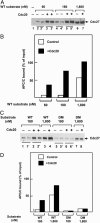Roles of the anaphase-promoting complex/cyclosome and of its activator Cdc20 in functional substrate binding
- PMID: 16455800
- PMCID: PMC1413726
- DOI: 10.1073/pnas.0510695103
Roles of the anaphase-promoting complex/cyclosome and of its activator Cdc20 in functional substrate binding
Erratum in
- Proc Natl Acad Sci U S A. 2006 Mar 28;103(13):5242
Abstract
The anaphase-promoting complex/cyclosome (APC/C) is a multisubunit ubiquitin-protein ligase that targets for degradation cell-cycle regulatory proteins during exit from mitosis and in the G1 phase of the cell cycle. The activity of APC/C in mitosis and in G1 requires interaction with the activator proteins Cdc20 and Cdh1, respectively. Substrates of APC/C-Cdc20 contain a recognition motif called the "destruction box" (D-box). The mode of the action of APC/C activators and their possible role in substrate binding remain poorly understood. Several investigators suggested that Cdc20 and Cdh1 mediate substrate recognition, whereas others proposed that substrates bind to APC/C or to APC/C-activator complexes. All these studies used binding assays, which do not necessarily indicate that substrate binding is functional and leads to product formation. In the present investigation we examined this problem by an "isotope-trapping" approach that directly demonstrates productive substrate binding. With this method we found that the simultaneous presence of both APC/C and Cdc20 is required for functional substrate binding. By contrast, with conventional binding assays we found that either Cdc20 or APC/C can bind substrate by itself, but only at low affinity and relaxed selectivity for D-box. Our results are consistent with models in which interaction of substrate with specific binding sites on both APC/C and Cdc20 is involved in selective and productive substrate binding.
Conflict of interest statement
Conflict of interest statement: No conflicts declared.
Figures




References
Publication types
MeSH terms
Substances
LinkOut - more resources
Full Text Sources
Miscellaneous

